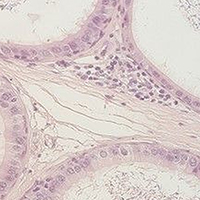 Smart Citations
Smart CitationsSee how this article has been cited at scite.ai
scite shows how a scientific paper has been cited by providing the context of the citation, a classification describing whether it supports, mentions, or contrasts the cited claim, and a label indicating in which section the citation was made.
Morphological and morphometric changes and epithelial apoptosis are induced in the rat epididymis by long-term letrozole treatment
The epididymis is an organ that plays a key role in sperm maturation. The aim of this study was to examine the association between the chronic treatment of mature male rats with letrozole and morphological evaluation and morphometric values of epididymis as well as changes in the number of apoptotic cells in epididymal epithelium. Adult rats were treated with letrozole for 6 months and the epididymis weight, morphology, morphometric values and the number of apoptotic cells in the epithelium were examined. Long-term aromatase inhibition resulted in presence of intraepithelial clear vacuoles, hyperplasia of clear cells and a hyperplastic alteration in the epithelium known as a cribriform change. Moreover, changes in diameters of the epididymal duct and the epididymal lumen and changes in the epididymal epithelium height were observed. The number of apoptotic epithelial cells was increased in letrozole-treated group. It can be indicated that chronic treatment with letrozole can affect morphology, morphometric values and apoptosis in the epididymis of adult male rats. Observed changes are similar to that observed in the aging processes and may also be important for patients treated with aromatase inhibitors.
Downloads
Publication Facts
Reviewer profiles N/A
Author statements
- Academic society
- N/A
- Publisher
- PAGEPress Publications, Pavia, Italy
How to Cite
PAGEPress has chosen to apply the Creative Commons Attribution NonCommercial 4.0 International License (CC BY-NC 4.0) to all manuscripts to be published.

 https://doi.org/10.4081/ejh.2021.3259
https://doi.org/10.4081/ejh.2021.3259






